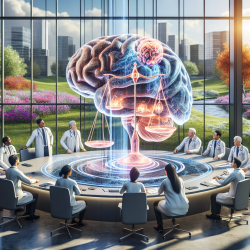Introduction
In the rapidly evolving world of nephropathology, the integration of artificial intelligence (AI) is not just a trend but a necessity. The systematic review titled Time for a full digital approach in nephropathology: a systematic review of current artificial intelligence applications and future directions explores the burgeoning role of AI in this specialized field. This blog post will delve into the findings of the review and discuss how practitioners can enhance their skills and outcomes by embracing these technological advancements.
The Role of AI in Nephropathology
The application of AI in nephropathology has seen a significant increase over the past seven years, particularly in the United States. This surge is largely due to AI's ability to perform complex tasks such as glomerular multi-stain classification and the segmentation of renal biopsy images. By utilizing deep learning algorithms, AI can identify patterns in complex histopathology data, which is crucial for the comprehensive assessment of renal biopsies.
For practitioners, this means a shift from manual, time-consuming tasks to more efficient, AI-driven processes. The ability of AI to handle large datasets and perform intricate analyses can significantly reduce the workload of nephropathologists, allowing them to focus on more critical diagnostic tasks.
Implementing AI: A Step-by-Step Guide
To effectively integrate AI into nephropathology practice, practitioners should consider the following steps:
- Collaborate with Experts: Form multidisciplinary teams that include nephropathologists, computer scientists, and clinicians. This collaboration is essential for developing clinically relevant AI tools.
- Embrace Hybrid Learning: Utilize hybrid and collaborative learning approaches to leverage large amounts of unlabeled data. This can enhance the accuracy and efficiency of AI models.
- Invest in Training: Develop training programs for pathologists to equip them with the necessary skills to work with AI tools effectively.
- Stay Informed: Keep up with the latest research and advancements in AI applications in nephropathology to ensure the adoption of the most effective tools and techniques.
Future Directions
The future of nephropathology lies in the continued integration of AI and digital pathology solutions. As AI tools become more sophisticated, they will likely receive official approval from healthcare regulatory agencies, moving from experimental to routine use. This shift will necessitate the development of standardized datasets and the incorporation of clinical data to enhance the accuracy of AI classifiers.
Moreover, the combination of AI with other technologies, such as biomarker discovery and "omics," will provide deeper insights into kidney diseases, leading to improved diagnosis and treatment outcomes.
Conclusion
As the field of nephropathology continues to evolve, practitioners must adapt to the digital transformation by embracing AI technologies. By doing so, they can enhance their diagnostic capabilities, improve patient outcomes, and contribute to the advancement of this critical medical field.
To read the original research paper, please follow this link: Time for a full digital approach in nephropathology: a systematic review of current artificial intelligence applications and future directions.










